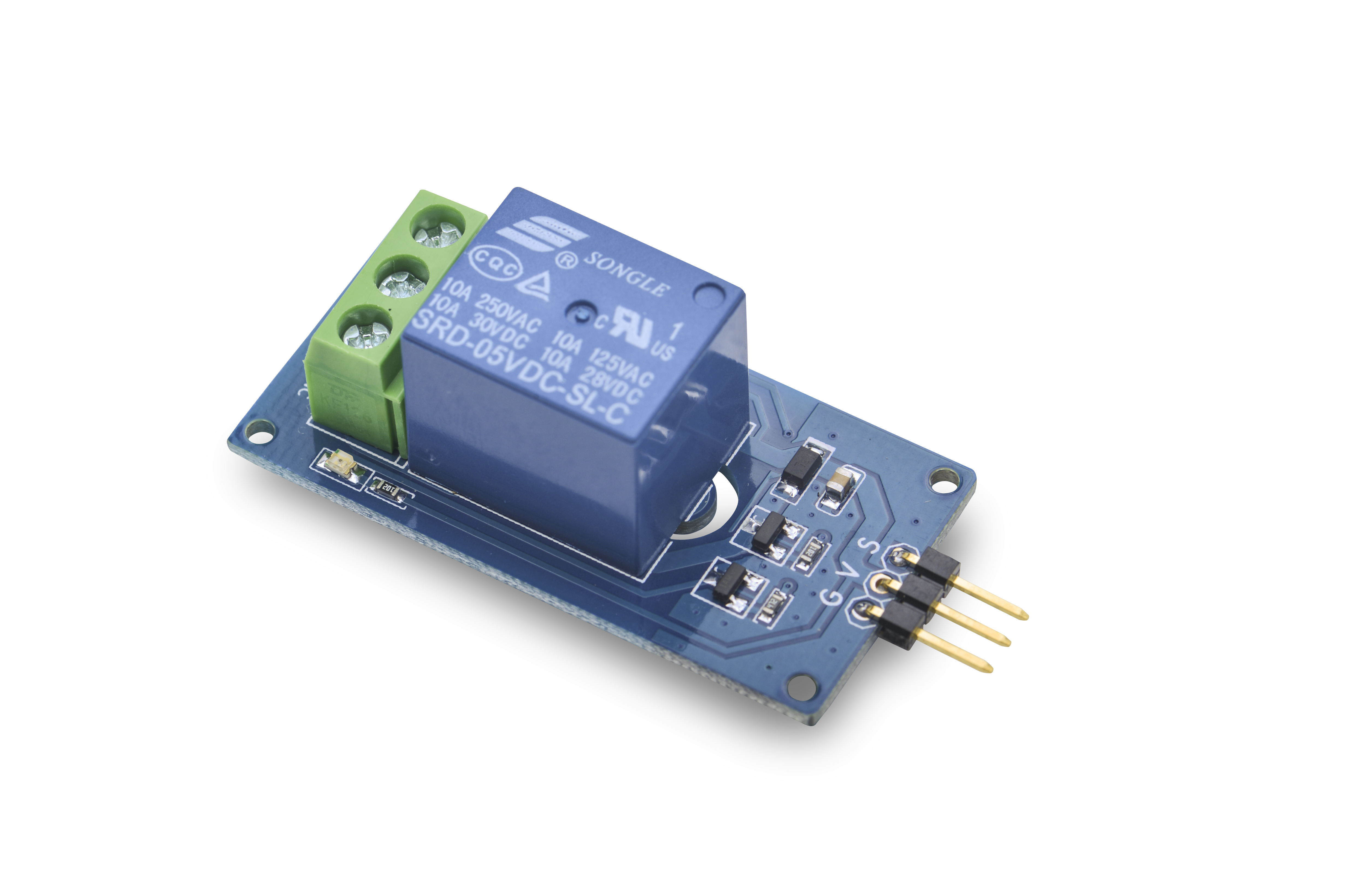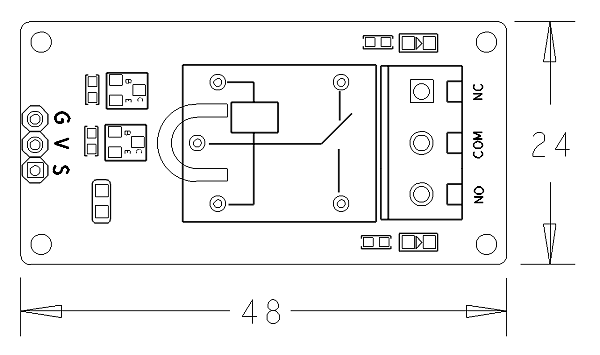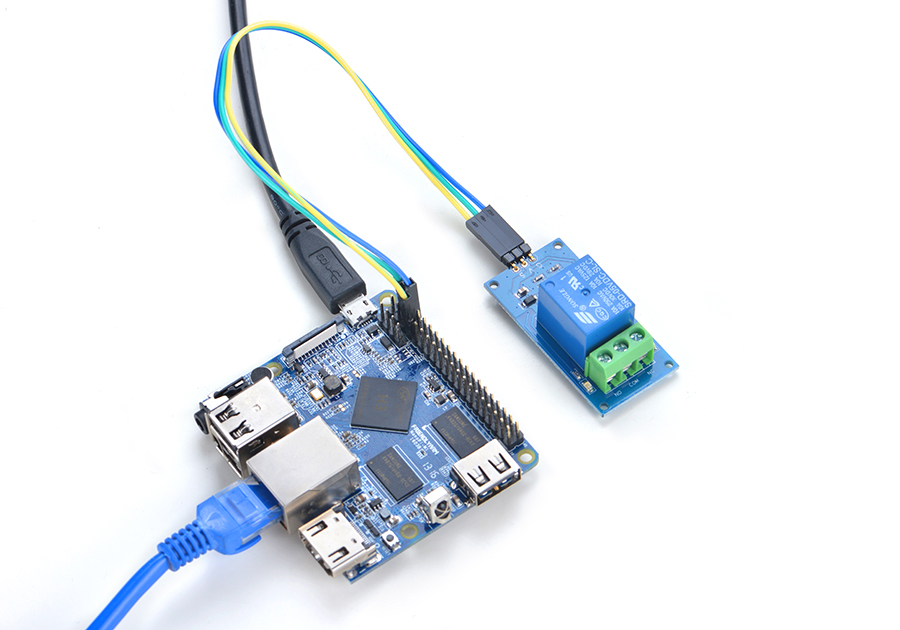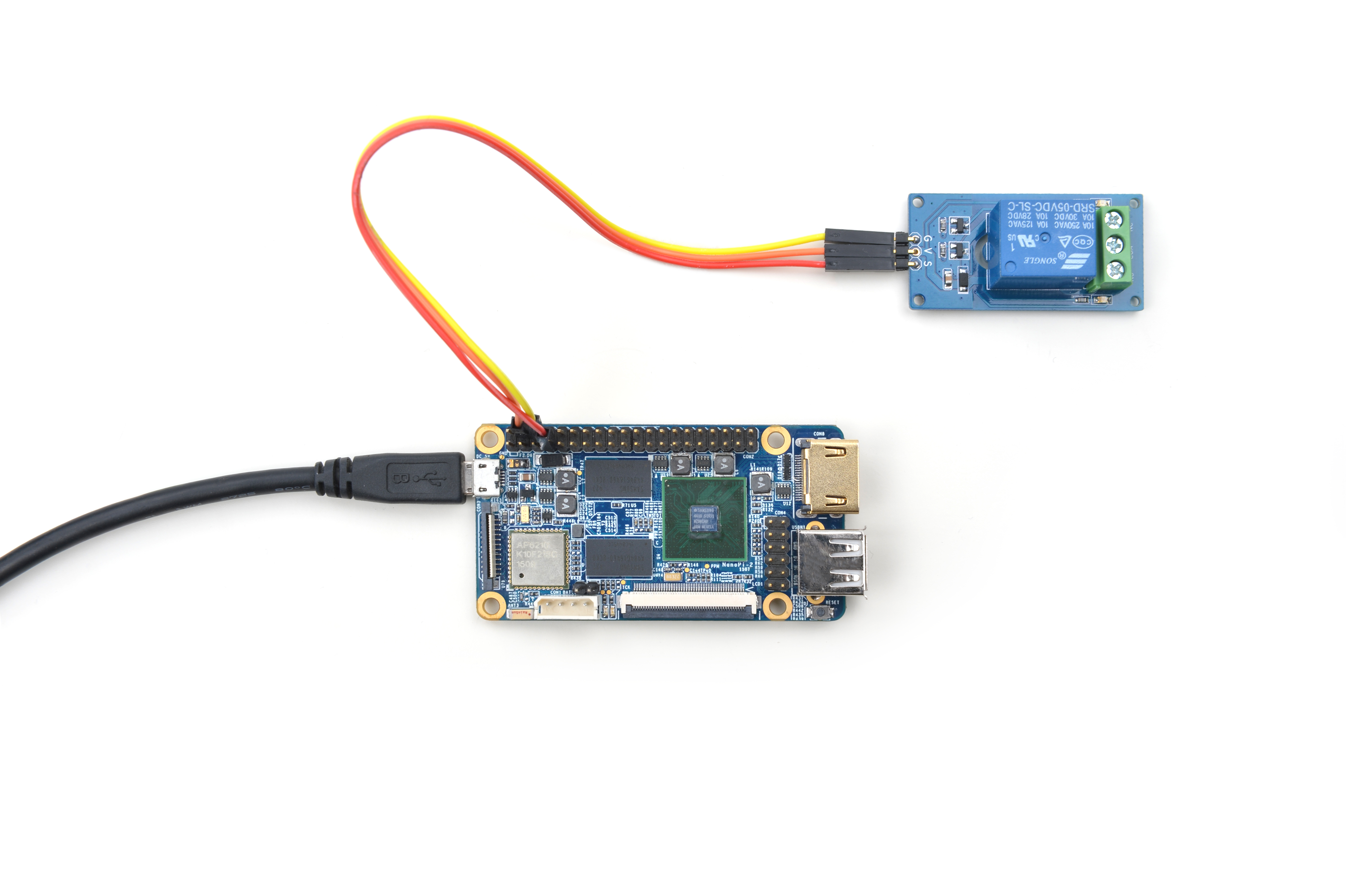Difference between revisions of "Matrix - Relay/zh"
From FriendlyELEC WiKi
(→特性) |
(→连接NanoPC-T2) |
||
| (46 intermediate revisions by 3 users not shown) | |||
| Line 1: | Line 1: | ||
[[Matrix - Relay|English]] | [[Matrix - Relay|English]] | ||
| − | == | + | ==介绍== |
[[File:relay01.png|thumb|Relay]] | [[File:relay01.png|thumb|Relay]] | ||
| − | + | *模块Matrix-Relay这是一个单刀双掷继电器,通常应用于自动控制电路中,它实际上是用较小的电流去控制较大电流的一种“自动开关”。故在电路中起着自动调节、安全保护、转换电路等作用。 | |
| − | == | + | ==特性== |
* 1 Form C | * 1 Form C | ||
* 5V线圈电压,控制信号为3.3/5V | * 5V线圈电压,控制信号为3.3/5V | ||
| Line 11: | Line 11: | ||
* LED指示 | * LED指示 | ||
* 2.54mm排针接口,接线方便,通用性强 | * 2.54mm排针接口,接线方便,通用性强 | ||
| + | * PCB尺寸(mm):24x48 | ||
| + | [[File:relaypcb.png|frameless|400px|继电器PCB]] | ||
| − | + | * 引脚说明: | |
| − | = | + | {| class="wikitable" |
| − | + | |- | |
| − | + | |名称 || 描述 | |
| + | |- | ||
| + | |S || GPIO | ||
| + | |- | ||
| + | |V || 电源5V | ||
| + | |- | ||
| + | |G || 地 | ||
| + | |} | ||
| − | === | + | ==工作原理== |
| − | + | 这是一个单刀双掷继电器,线圈电压为直流5V,触点电流可达10A,适合驱动直流或交流大功率负载。NO为常开触点,NC为常闭触点,COM为公共触点。当向S引脚施加高电平,继电器线圈导通,此时NO触点断开,NC触点闭合。 | |
| − | + | ||
| − | + | ||
| − | + | ||
| − | + | ==硬件连接== | |
| − | + | ===连接NanoPi NEO/NanoPi NEO Air=== | |
| − | + | NanoPi M1和NanoPi NEO以及NanoPi NEO Air的前24Pin引脚定义是一模一样的,所以它们操作Matrix配件的步骤是一样的,并且使用同一份代码。<br> | |
| − | + | ||
| − | + | ||
| − | + | ||
| − | + | ||
| − | + | ||
| − | + | ||
| − | int pin = | + | 参考下图连接模块:<br> |
| + | [[File:Matrix-Relay_nanopi_NEO.jpg|frameless|600px|Matrix-Relay_nanopi_NEO]] | ||
| + | |||
| + | 连接说明: | ||
| + | {| class="wikitable" | ||
| + | |- | ||
| + | |Matrix-Relay || NanoPi NEO | ||
| + | |- | ||
| + | |S || Pin7 | ||
| + | |- | ||
| + | |V || Pin4 | ||
| + | |- | ||
| + | |G || Pin6 | ||
| + | |} | ||
| + | |||
| + | ===连接NanoPi M1=== | ||
| + | 参考下图连接模块:<br> | ||
| + | [[File:Matrix-Relay_nanopi_m1.jpg|frameless|600px|Matrix-Relay_nanopi_m1]] | ||
| + | |||
| + | 连接说明: | ||
| + | {| class="wikitable" | ||
| + | |- | ||
| + | |Matrix-Relay || NanoPi M1 | ||
| + | |- | ||
| + | |S || Pin7 | ||
| + | |- | ||
| + | |V || Pin4 | ||
| + | |- | ||
| + | |G || Pin6 | ||
| + | |} | ||
| + | |||
| + | ===连接NanoPi 2=== | ||
| + | 参考下图连接模块:<br> | ||
| + | [[File:Matrix-Relay_nanopi_2.jpg|frameless|600px|Matrix-Relay_nanopi_2]] | ||
| + | |||
| + | 连接说明: | ||
| + | {| class="wikitable" | ||
| + | |- | ||
| + | |Matrix-Relay || NanoPi 2 | ||
| + | |- | ||
| + | |S || Pin7 | ||
| + | |- | ||
| + | |V || Pin4 | ||
| + | |- | ||
| + | |G || Pin6 | ||
| + | |} | ||
| + | |||
| + | ===连接NanoPi M2 / NanoPi 2 Fire=== | ||
| + | NanoPi M2和NanoPi 2 Fire的40 Pin引脚定义是一模一样的,所以它们操作Matrix配件的步骤是一样的,这里仅以NanoPi M2为例。<br> | ||
| + | 参考下图连接模块:<br> | ||
| + | [[File:Matrix-Relay_nanopi_m2.jpg|frameless|600px|Matrix-Relay_nanopi_m2]] | ||
| + | |||
| + | 连接说明: | ||
| + | {| class="wikitable" | ||
| + | |- | ||
| + | |Matrix-Relay || NanoPi M2 | ||
| + | |- | ||
| + | |S || Pin7 | ||
| + | |- | ||
| + | |V || Pin4 | ||
| + | |- | ||
| + | |G || Pin6 | ||
| + | |} | ||
| + | |||
| + | ===连接NanoPi M3=== | ||
| + | 参考下图连接模块:<br> | ||
| + | [[File:Matrix-Relay_nanopi_m3.jpg|frameless|600px|Matrix-Relay_nanopi_m3]] | ||
| + | |||
| + | 连接说明: | ||
| + | {| class="wikitable" | ||
| + | |- | ||
| + | |Matrix-Relay || NanoPi M3 | ||
| + | |- | ||
| + | |S || Pin7 | ||
| + | |- | ||
| + | |V || Pin4 | ||
| + | |- | ||
| + | |G || Pin6 | ||
| + | |} | ||
| + | |||
| + | ===连接NanoPC-T2/NanoPC-T3=== | ||
| + | 由于NanoPC-T2跟NanoPC-T3的引脚是一样的,所以连接方式是一样的,这里仅以T2为例,参考下图连接模块:<br> | ||
| + | [[File:Matrix-Relay_NanoPC-T2.jpg|frameless|600px|Matrix-Relay_NanoPC-T2]] | ||
| + | |||
| + | 连接说明: | ||
| + | {| class="wikitable" | ||
| + | |- | ||
| + | |Matrix-Relay || NanoPC-T2 | ||
| + | |- | ||
| + | |S || Pin15 | ||
| + | |- | ||
| + | |V || Pin29 | ||
| + | |- | ||
| + | |G || Pin30 | ||
| + | |} | ||
| + | |||
| + | ==编译运行测试程序== | ||
| + | 启动开发板并运行Debian系统,进入系统后克隆Matrix代码仓库: | ||
| + | <syntaxhighlight lang="bash"> | ||
| + | $ apt-get update && apt-get install git | ||
| + | $ git clone https://github.com/friendlyarm/matrix.git | ||
| + | </syntaxhighlight> | ||
| + | 克隆完成后会得到一个名为matrix的目录。 | ||
| + | |||
| + | 编译并安装Matrix: | ||
| + | <syntaxhighlight lang="bash"> | ||
| + | $ cd matrix | ||
| + | $ make && make install | ||
| + | </syntaxhighlight> | ||
| + | |||
| + | 运行测试程序: | ||
| + | <syntaxhighlight lang="bash"> | ||
| + | $ matrix-gpio_out | ||
| + | </syntaxhighlight> | ||
| + | 注意:此模块并不支持热插拔,启动系统前需要确保硬件连接正确。<br> | ||
| + | 运行效果如下:<br> | ||
| + | <syntaxhighlight lang="bash"> | ||
| + | 1: gpio status change | ||
| + | 2: gpio status change | ||
| + | 3: gpio status change | ||
| + | 4: gpio status change | ||
| + | 5: gpio status change | ||
| + | </syntaxhighlight> | ||
| + | |||
| + | ==代码说明== | ||
| + | 所有的开发板都共用一套Matrix代码,本模块的测试示例代码为matrix-gpio_out,内容如下: | ||
| + | <syntaxhighlight lang="c"> | ||
| + | int main(int argc, char ** argv) | ||
| + | { | ||
| + | int pin = GPIO_PIN(7); | ||
| + | int i, value, board; | ||
int ret = -1; | int ret = -1; | ||
| − | if (( | + | |
| − | printf(" | + | if ((board = boardInit()) < 0) { |
| + | printf("Fail to init board\n"); | ||
| + | return -1; | ||
} | } | ||
| − | if ((ret = | + | if (board == BOARD_NANOPI_T2) |
| − | printf(" | + | pin = GPIO_PIN(15); |
| + | |||
| + | if (argc == 2) | ||
| + | pin = GPIO_PIN(atoi(argv[1])); | ||
| + | if ((ret = exportGPIOPin(pin)) == -1) { | ||
| + | printf("exportGPIOPin(%d) failed\n", pin); | ||
} | } | ||
| − | + | if ((ret = setGPIODirection(pin, GPIO_OUT)) == -1) { | |
| − | if ( | + | printf("setGPIODirection(%d) failed\n", pin); |
| − | + | ||
| − | + | ||
| − | + | ||
} | } | ||
| − | + | for (i = 0; i < STATUS_CHANGE_TIMES; i++) { | |
| + | if (i % 2) { | ||
| + | value = GPIO_HIGH; | ||
| + | } else { | ||
| + | value = GPIO_LOW; | ||
| + | } | ||
| + | if ((ret = setGPIOValue(pin, value)) > 0) { | ||
| + | printf("%d: GPIO_PIN(%d) value is %d\n", i+1, pin, value); | ||
| + | } else { | ||
| + | printf("setGPIOValue(%d) failed\n", pin); | ||
| + | } | ||
| + | sleep(1); | ||
| + | } | ||
| + | unexportGPIOPin(pin); | ||
| + | return 0; | ||
} | } | ||
</syntaxhighlight> | </syntaxhighlight> | ||
| + | API说明参考维基:[[Matrix API reference manual/zh|Matrix API reference manual]] <br> | ||
| − | == | + | ==相关资料== |
| − | + | ||
| − | + | ||
| − | + | ||
| − | + | ||
| − | + | ||
| − | + | ||
| − | + | ||
| − | + | ||
| − | + | ||
| − | + | ||
Latest revision as of 08:56, 10 November 2016
Contents
[hide]1 介绍
- 模块Matrix-Relay这是一个单刀双掷继电器,通常应用于自动控制电路中,它实际上是用较小的电流去控制较大电流的一种“自动开关”。故在电路中起着自动调节、安全保护、转换电路等作用。
2 特性
- 1 Form C
- 5V线圈电压,控制信号为3.3/5V
- 触点电流可达10A
- LED指示
- 2.54mm排针接口,接线方便,通用性强
- PCB尺寸(mm):24x48
- 引脚说明:
| 名称 | 描述 |
| S | GPIO |
| V | 电源5V |
| G | 地 |
3 工作原理
这是一个单刀双掷继电器,线圈电压为直流5V,触点电流可达10A,适合驱动直流或交流大功率负载。NO为常开触点,NC为常闭触点,COM为公共触点。当向S引脚施加高电平,继电器线圈导通,此时NO触点断开,NC触点闭合。
4 硬件连接
4.1 连接NanoPi NEO/NanoPi NEO Air
NanoPi M1和NanoPi NEO以及NanoPi NEO Air的前24Pin引脚定义是一模一样的,所以它们操作Matrix配件的步骤是一样的,并且使用同一份代码。
参考下图连接模块:
Matrix-Relay_nanopi_NEO
连接说明:
| Matrix-Relay | NanoPi NEO |
| S | Pin7 |
| V | Pin4 |
| G | Pin6 |
4.2 连接NanoPi M1
连接说明:
| Matrix-Relay | NanoPi M1 |
| S | Pin7 |
| V | Pin4 |
| G | Pin6 |
4.3 连接NanoPi 2
连接说明:
| Matrix-Relay | NanoPi 2 |
| S | Pin7 |
| V | Pin4 |
| G | Pin6 |
4.4 连接NanoPi M2 / NanoPi 2 Fire
NanoPi M2和NanoPi 2 Fire的40 Pin引脚定义是一模一样的,所以它们操作Matrix配件的步骤是一样的,这里仅以NanoPi M2为例。
参考下图连接模块:
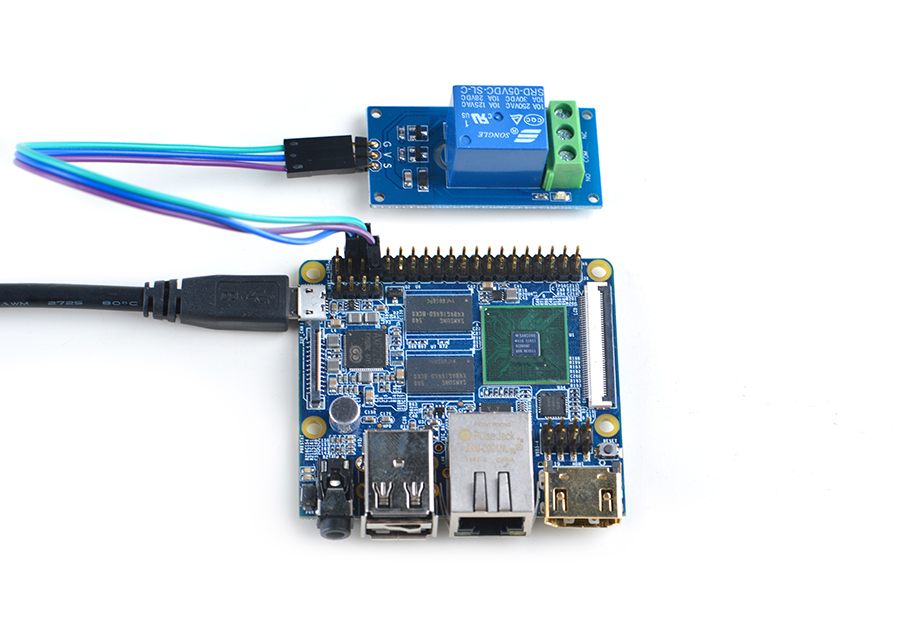
连接说明:
| Matrix-Relay | NanoPi M2 |
| S | Pin7 |
| V | Pin4 |
| G | Pin6 |
4.5 连接NanoPi M3
参考下图连接模块:
Matrix-Relay_nanopi_m3
连接说明:
| Matrix-Relay | NanoPi M3 |
| S | Pin7 |
| V | Pin4 |
| G | Pin6 |
4.6 连接NanoPC-T2/NanoPC-T3
由于NanoPC-T2跟NanoPC-T3的引脚是一样的,所以连接方式是一样的,这里仅以T2为例,参考下图连接模块:
Matrix-Relay_NanoPC-T2
连接说明:
| Matrix-Relay | NanoPC-T2 |
| S | Pin15 |
| V | Pin29 |
| G | Pin30 |
5 编译运行测试程序
启动开发板并运行Debian系统,进入系统后克隆Matrix代码仓库:
$ apt-get update && apt-get install git $ git clone https://github.com/friendlyarm/matrix.git
克隆完成后会得到一个名为matrix的目录。
编译并安装Matrix:
$ cd matrix $ make && make install
运行测试程序:
$ matrix-gpio_out注意:此模块并不支持热插拔,启动系统前需要确保硬件连接正确。
运行效果如下:
1: gpio status change 2: gpio status change 3: gpio status change 4: gpio status change 5: gpio status change
6 代码说明
所有的开发板都共用一套Matrix代码,本模块的测试示例代码为matrix-gpio_out,内容如下:
int main(int argc, char ** argv) { int pin = GPIO_PIN(7); int i, value, board; int ret = -1; if ((board = boardInit()) < 0) { printf("Fail to init board\n"); return -1; } if (board == BOARD_NANOPI_T2) pin = GPIO_PIN(15); if (argc == 2) pin = GPIO_PIN(atoi(argv[1])); if ((ret = exportGPIOPin(pin)) == -1) { printf("exportGPIOPin(%d) failed\n", pin); } if ((ret = setGPIODirection(pin, GPIO_OUT)) == -1) { printf("setGPIODirection(%d) failed\n", pin); } for (i = 0; i < STATUS_CHANGE_TIMES; i++) { if (i % 2) { value = GPIO_HIGH; } else { value = GPIO_LOW; } if ((ret = setGPIOValue(pin, value)) > 0) { printf("%d: GPIO_PIN(%d) value is %d\n", i+1, pin, value); } else { printf("setGPIOValue(%d) failed\n", pin); } sleep(1); } unexportGPIOPin(pin); return 0; }
API说明参考维基:Matrix API reference manual
